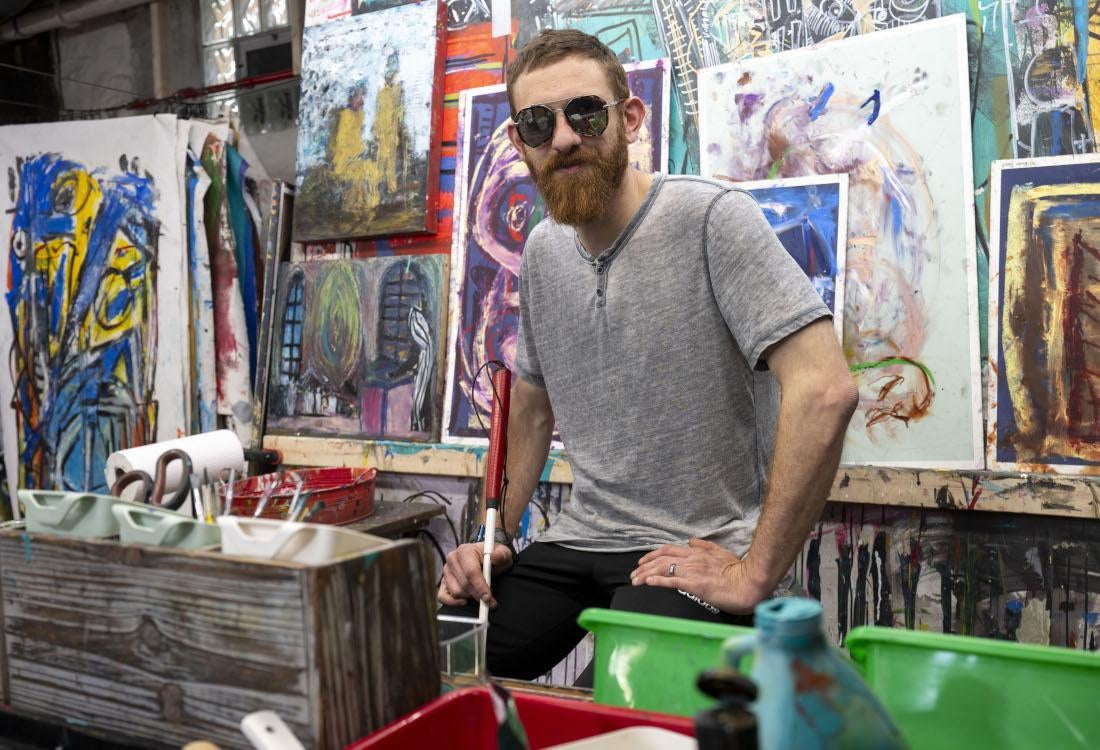
Benny Schwartz sits on the porch at his friend’s engagement party, pointedly avoiding the revelry inside. In the years since being diagnosed with an advancing autoimmune disease that's slowly stealing his vision, he’s vacillated between apathy and anger, neither of which make him much fun at parties. He’d rather be alone.
But soon, an old acquaintance from high school interrupts Schwartz’s solitude, joining him on the porch and asking how he’s been. It’s a loaded question. Schwartz’s disease won’t let him work or drive or read or any of the things that once kept him occupied.
“Bored,” Schwartz tells him. “I’m bored.”
“If you’re bored,” the friend replies, “create, create, create!”
That evening, upon returning to his home in Pittsburgh's Squirrel Hill neighborhood, Schwartz picks up a piece of his son’s discarded pastels and begins to sketch for the first time in decades. The shapes that emerge aren’t the intricate doodles of his youth, but something looser and less meticulous. Unconcerned with perfection or perception, he moves on instinct until he feels the drawing is done.
And then, against all odds, Schwartz’s world tilts just a bit toward normalcy.
“Every time I opened my eyes, every time I looked around, I was either pitying myself or being angry about the visual loss,” Schwartz says. “Now I was involved in something visual that I was in control of — it was liberating.”
Five years later, Benny Schwartz is Benny Blindspots, a prolific painter with a clever moniker whose work hangs in galleries (most recently The Manos Gallery in Tarentum, Pennsylvania) and sells online through ArtLifting, an organization that promotes artists affected by disabilities or housing insecurity. That’s how Bank of America found his colorful, abstract compositions and purchased 50 prints for multiple locations across the country.
It wasn’t at all the life Schwartz envisioned as a student at Pitt in the late aughts. He figured he would earn a degree in psychology, propose to his longtime girlfriend at the Cathedral of Learning and search for a good graduate program. But, just three years after earning that degree and getting married, he was hit with vertigo and nausea so intense, they forced him to take an extended leave from his job at The Children’s Institute.
After months of painful tests and worsening symptoms — including excessive fatigue and vision loss — doctors finally offered a diagnosis of neuromyelitis optica (NMO), an autoimmune disease that can cause blindness, paralysis and brain lesions. Treatment, including low-dose chemotherapy to suppress the immune system, is nearly as debilitating as the disease itself and leaves him susceptible to other illness, but it has mostly kept NMO attacks at bay. His vision, as his alias suggests, is freckled with dark or blurry patches that make reading faces particularly difficult.
Art is the salve for that pain.
When he feels the need to create, Schwartz (A&S ’11) descends to his basement art studio with a broad theme and a blank canvas, layering vibrant, frenetic strokes to build dimension. Because he perceives color differently than most, he focuses on contrast, understanding what viewers eventually see may be wholly different than what he intended. Sometimes, the process is excruciating. It can take days or weeks before Schwartz’s colorful, fantastical imaginings — what he calls his “dreamscapes” — finally come to life. His wife, Rina (SHRS ’12), and 6-year-old son, who serve as inspiration for much of his art, often think his work is done long before he does.
But, for him, the healing happens in the painting.
“It is important to know when to stop, but at the same time, I believe every layer is somehow related to the end,” he says. “It’s impossible to have the final product without the process.”



